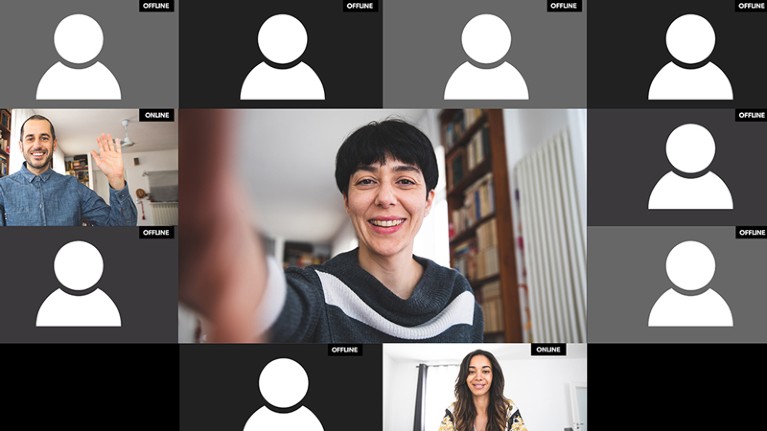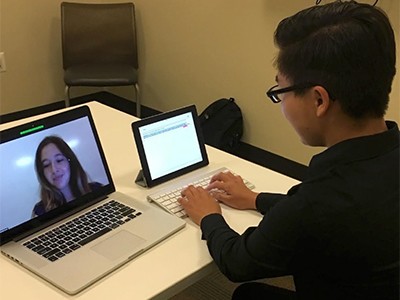
New tools have the potential to boost creativity in online spaces.Credit: Getty
Early in 2020, workers around the world were plunged into a new reality of remote working. In doing so, they also participated in a series of unexpected global experiments: social scientists have spent much of the past two years analysing what happens when face-to-face exchanges are replaced by online meetings. And their results are starting to come in. The pandemic has taught the world about hybrid working. Now, there’s growing evidence for employers to use when deciding about the future work environment.
Some of the findings might seem predictable: for example, that in-person interactions are better for brainstorming and for building relationships than is remote working. Last year, Nature Human Behaviour reported the results of a study1 involving some 60,000 staff members at tech giant Microsoft who had moved to remote working in 2020. The study found that collaboration had slowed with the change, and that there were fewer opportunities for groups of colleagues to work together or share information.
Conversely, cutting out long commutes saves time; and, in some jobs, as a study of employees in China found2, staff are more productive and benefit from greater autonomy when working remotely. Moreover, universities report that courses offering ‘blended’ learning (both in-person and virtual or recorded classes) are popular with students unable to commute to, or live near, their universities.
Read the paper: Virtual communication curbs creative idea generation
Research published in Nature this week proposes that, in some instances, in-person collaboration can foster greater creativity than when people work together using videoconferencing3. Melanie Brucks at Columbia University in New York City and Jonathan Levav at Stanford University, California, combined laboratory-based and field research to assess the impact of remote working on creativity and idea selection. As part of the study, the team created an experiment (which started before the pandemic) involving a group of around 600 people, split into pairs. One set of pairs worked together in the same space (pre-pandemic conditions); the second set collaborated virtually from separate rooms. Each pair was given five minutes to come up with creative uses for two everyday objects: a frisbee and some bubble wrap. The researchers found that the pairs collaborating through Zoom-style videoconferencing generated fewer innovative ideas than did those working in the same physical space.
The researchers then tested whether their lab-based results stood up to real-world conditions. To do this, they studied around 1,500 engineers working for a telecoms company with offices in 5 countries. Once more, the group was divided into virtual and in-person pairs and given a task similar to that in the lab-based study. The results held — in-person teams came up with more creative ideas than did remotely based teams.
Scientists count the career costs of COVID
So, why was physical proximity better for creativity in these experiments? As one possible explanation, the researchers found that creativity correlated with the ability to move about, and to look around at the contents of a room. Pairs that were more creative spent more time looking at their surroundings. The virtual pairs, by contrast, tended to stay fixated on their computer screens, narrowing the focus of their ideas to a small rectangle.
But some aspects were not negatively affected by videoconferencing. For example, there were no differences between the two groups in the selection of ideas to pursue from a list of suggestions. And trust remained at the same levels between both types of group.
This study is one of several that describes or compares the experiences of people working virtually and in person. Last year, Rabindra Ratan at Michigan State University in East Lansing and his colleagues found that people working remotely experience ‘virtual-meeting fatigue’, and describe being dissatisfied with their facial appearance on screens4. The constant need to look at themselves induces tiredness.
The hybrid way
The results of these and ongoing experiments are based on existing videoconferencing tools and technologies. These are constantly evolving, and it’s possible that newer technologies could narrow the creativity deficit. For example, collaborative software (such as virtual whiteboards), which is becoming more common in business, education and research, allows for more fluid and informal information-sharing in virtual settings.
Clearly, hybrid working is here to stay, in part because of the benefits in terms of broader access to work, convenience and reduced commuting times and travel costs. Now is the time to build on what has been learnt, to make hybrid and remote working successful in their own right — and to ensure that they are not just a poor replacement for fully in-person interactions.
As many prepare to return to the workplace, organizations should continue to experiment with various models and to keep track of the relevant research. Scientists, too, should keep on exploring the conditions in which remote working can be satisfying and productive.
Research can help to both identify opportunities suited to virtual collaboration, and alert organizations to situations in which such interactions could harm both productivity and well-being.

 Read the paper: Virtual communication curbs creative idea generation
Read the paper: Virtual communication curbs creative idea generation
 Scientists count the career costs of COVID
Scientists count the career costs of COVID
 Virtual collaboration hinders a key component of creativity
Virtual collaboration hinders a key component of creativity
 Pandemic burnout is rampant in academia
Pandemic burnout is rampant in academia
 The effects of remote work on collaboration among information workers
The effects of remote work on collaboration among information workers





